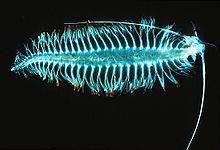- Parapodium
-
Parapodia (Gr. para, beyond or beside + podia, feet), singular parapodium, are paired, un-jointed lateral outgrowths from the bodies of two different invertebrate groups, which are primarily marine in habitat. These structures are characteristic of Polychaeta, and several clades of sea snails and sea slugs.
Contents
In polychaete worms
Parapodia in polychaetes are either uniramous or biramous. In the latter case, the dorsal lobes or branches are called notopodia and the ventral branches neuropodia.
Both neuropodia and notopodia can bear cirri (called respectively neurocirri and notocirri) and setae (called respectively neurosetae and notosetae). The cirri between the two branches are called interramal cirri.
In opisthobranch gastropod mollusks
The fleshy protrusions on the sides of some snails are also called parapodia (they are particularly well-developed in sea butterflies). Some sea hares also use their parapodia to swim. Parapodia can be used for respiration (such as gills) also they can be used for locomotion.
Parapodia are found in:
- Clade Cephalaspidea
- Clade Thecosomata
- Clade Gymnosomata
- Clade Aplysiomorpha
See also
- Epitoke parapodium
References
Categories:- Annelid anatomy
- Mollusc anatomy
Wikimedia Foundation. 2010.

